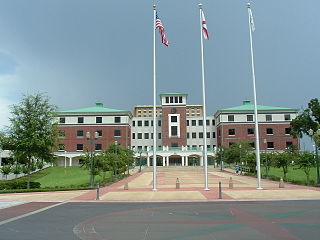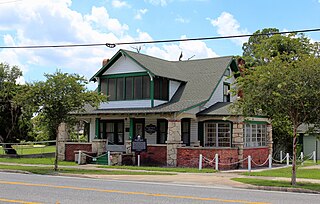
Volusia County is located in the east-central part of the U.S. state of Florida between the St. Johns River and the Atlantic Ocean. As of the 2020 census, the county was home to 553,543 people, an increase of 11.9% from the 2010 census. It was founded on December 29, 1854, from part of Orange County, and was named for the community of Volusia, located in northwestern Volusia County. Its first county seat was Enterprise. Since 1887, its county seat has been DeLand.

Daytona Beach, or simply Daytona, is a coastal resort city in Volusia County, Florida, United States. Located on the East Coast of the United States, its population was 72,647 at the 2020 census. It is part of the Deltona–Daytona Beach–Ormond Beach metropolitan area, and is a principal city of the Fun Coast region of Florida.

DeLand is a city in and the county seat of Volusia County, Florida, United States. The city sits approximately 34 miles (55 km) north of the central business district of Orlando, and approximately 23 miles (37 km) west of the central business district of Daytona Beach. It is a part of the Deltona–Daytona Beach–Ormond Beach metropolitan area. As of the 2020 U.S. census, the population was 37,351.

Ormond-by-the-Sea is a census-designated place and an unincorporated town in Volusia County, Florida, United States. The population was 7,312 as of the 2020 census, a decrease from 7,406 in the 2010 census.

Coquina is a sedimentary rock that is composed either wholly or almost entirely of the transported, abraded, and mechanically sorted fragments of mollusks, trilobites, brachiopods, or other invertebrates. The term coquina comes from the Spanish word for "cockle" and "shellfish".

Fort Matanzas National Monument was designated a United States National Monument on October 15, 1924. The monument consists of a 1740 Spanish fort called Fort Matanzas, and about 100 acres (0.4 km2) of salt marsh and barrier islands along the Matanzas River on the northern Atlantic coast of Florida. It is operated by the National Park Service in conjunction with the Castillo de San Marcos National Monument in the city of St. Augustine.

90 West Street is a 23-story residential building in the Financial District of Lower Manhattan in New York City. Located on West Street just south of the World Trade Center, the building was designed by Cass Gilbert, with Gunvald Aus and Burt Harrison as structural engineers, and John Peirce as general contractor. It was erected for the West Street Improvement Corporation, led by transportation magnate Howard Carroll.

City Island, Daytona Beach, Florida, United States, is an island in the Halifax River between mainland Florida and the barrier islands/outer banks. Buildings on the island include the Daytona Tortugas' Jackie Robinson Ballpark, the city's courthouse, and the main branch of the Volusia County Library.

Daytona State College (DSC) is a public college with its main campus in Daytona Beach, Florida. DSC also has 6 smaller regional campuses throughout Volusia and Flagler counties. It is part of the Florida College System.

The New Smyrna Sugar Mill Ruins is a historic site in New Smyrna Beach, Florida, at 600 Old Mission Road, one mile west of the Intracoastal Waterway. On August 12, 1970, it was added to the U.S. National Register of Historic Places.

The González–Álvarez House, also known as The Oldest House, is a historic house museum at 14 St. Francis Street in St. Augustine, Florida. With a construction history dating to about 1723, it is believed to be the oldest surviving house in St. Augustine. It is also an important example of St. Augustine's Spanish colonial architectural style, with later modifications by English owners. It was designated a U.S. National Historic Landmark in 1970. The house is now owned by the St. Augustine Historical Society and is open for public tours as part of the Oldest House Museum Complex. Evidence can be seen of the Spanish, British, and American occupations of St. Augustine.

The Daytona Beach Bandshell is an amphitheatre in Daytona Beach, Florida, United States. It is located at Ocean Avenue, north of the junction of Main Street and Atlantic Avenue. On March 5, 1999, it was added to the U.S. National Register of Historic Places. On April 18, 2012, the AIA's Florida Chapter placed the Daytona Beach Bandshell on its list of Florida Architecture: 100 Years. 100 Places.

The former St. Andrew's Episcopal Church building, also known as Old St. Andrew's Event Venue, is an historic building located at 317 Florida Avenue in downtown Jacksonville, Florida. It was originally an Episcopal church, but closed when the parish relocated to the suburbs in 1960. On May 4, 1976, the edifice was added to the U.S. National Register of Historic Places. In the 1990s it was purchased by the City of Jacksonville and turned over to the Jacksonville Historical Society (JHS), and now serves as an event venue managed by the society.

Chana School is a Registered Historic Place in Ogle County, Illinois, in the county seat of Oregon, Illinois. One of six Oregon sites listed on the Register, the school is an oddly shaped, two-room schoolhouse which has been moved from its original location. Chana School joined the Register in 2005 as an education museum.

The Daytona Beach Boardwalk consists of the concrete promenade which was installed in the late 1920s, followed by the bandshell and coquina embellishments which were completed in 1938. It is a structure located on the beach in Daytona Beach, Florida at the east end of Main Street, east of Ocean Avenue. It is open seven days a week and consists of a concrete walkway with various stores and shops including the City Walk shopping and entertainment complex, hotels, gift shops, amusement centers, arcades, restaurants and bars. It also features outdoor and indoor rides like the Ferris wheel, Slingshot, Hurricane, Tilt-O-Whirl, go-carts and formerly a roller coaster called the Sand Blaster. Free concerts are given in the summer at the Bandshell on the north end of the area. The Daytona Beach Pier, also known as the Main Street Pier, was built by Thomas Keating in the late 1800s. The pier begins at the east end of Main Street, south of the boardwalk and extends 1,000 feet into the Atlantic Ocean.

Daytona Beach Coquina Clock Tower is a clock tower located in Daytona Beach, Florida. It is a contributing property within the Daytona Beach Bandshell and Oceanfront Park Complex historic district which was entered into the United States National Register of Historic Places (VO7135) on February 25, 1999 from a multiple property submission under the following areas of significance: Entertainment, Recreation, Community Planning and Development, and Architecture.

The Holden House, located at 204 E. Moody Blvd., Bunnell, Florida, was built in 1918 by Samuel Merwin Bortree (1859–1918) as a wedding gift for his daughter Ethel Lura Bortree Holden (1892–1977), and her husband Thomas Edward Holden (1892–1974). It is an excellent example of the Craftsman Bungalow architectural style. The house was purchased by Flagler County for $40,000 on August 6, 1979 from a Holden family member. It is now a museum that features artifacts from Flagler County and the general Florida area dating from the St. Johns Culture to the present. It is also the headquarters for the Flagler County Historical Society. The house's upstairs bathroom was one of the first indoor bathrooms in the Bunnell area and features unique small hexagon tiles on the floor which were similar to the flooring design used in the original owner's pharmacy building which is no longer extant and was located at the southwest corner of the intersection of Moody Boulevard and U.S. 1 in Bunnell. The Holden House was listed on the National Register of Historic Places on October 16, 2018.

Addison Blockhouse Historic State Park is a state park located in Volusia County, Florida. It features the Addison Blockhouse, a small coquina rock ruin that was on a 19th-century plantation and served as a kitchen as well as a fort.

The Nathan Cobb Cottage at 137 Orchand Lane in Ormond Beach, Florida is a half story residential structure that was constructed in 1897 from salvaged cargo and wood parts from the shipwreck of the Nathan F. Cobb schooner. A local man named William Fagen built the cottage in the vernacular architectural style using salvaged cargo and wood parts including railroad ties, flooring, balustrades and stairs.























